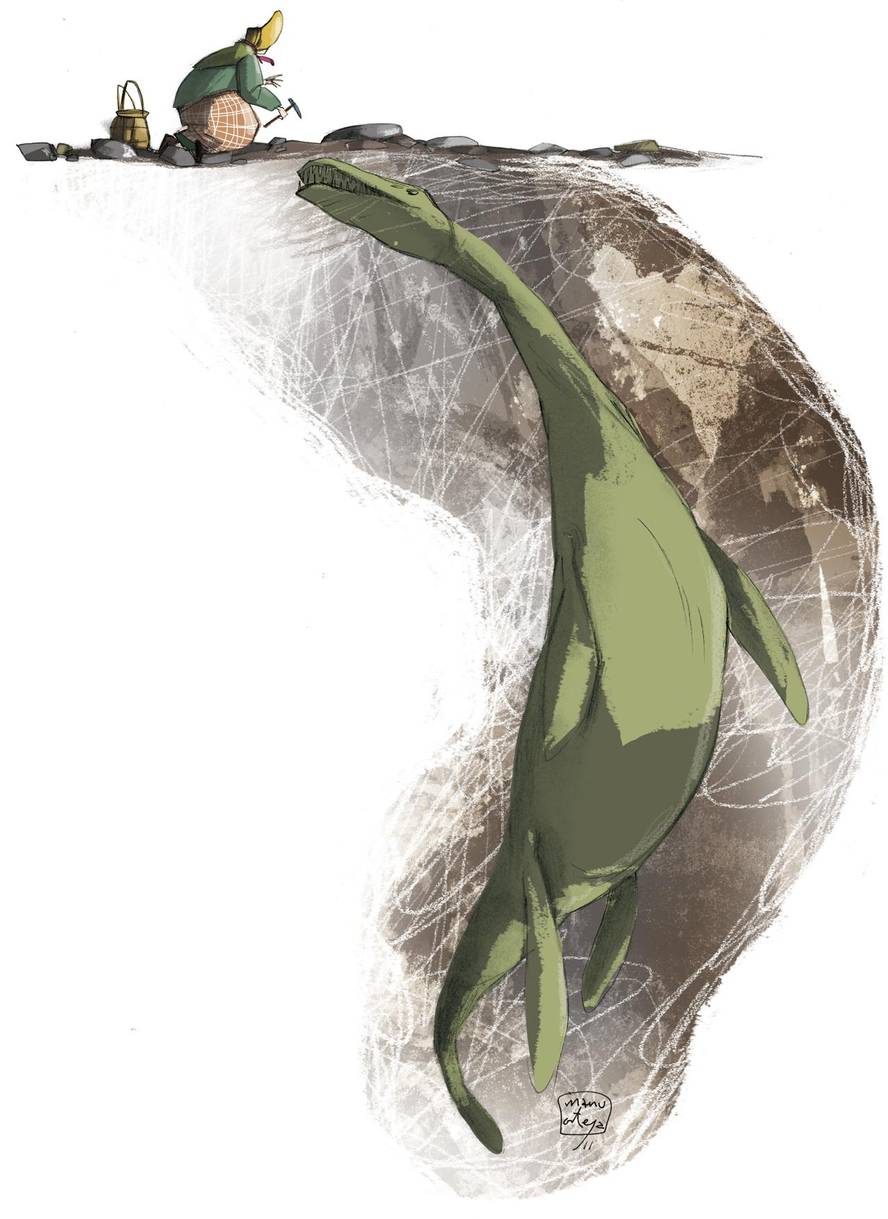Mary Anning, the Lady of Fossils
Joseph and Mary, two 15-12-year-old brothers who were traveling down the Lyme Regis cliff in England, looked for fossils as they did with their father. But that afternoon of 1811, Joseph discovered a skull of almost a metre and a half tall as never before. It looked like a crocodile!
Months later Mary discovered the rest of the skeleton. The "crocodile" appeared in the newspapers and aroused the attention of the scientists. The Everal Home published six articles about this fossil, which was inconceivable: some kind of fish, some relative of ornitorrino, an animal between arrabios and lizards... Finally, Charles Konig proposed the name of Ichthyosaurus (fish lizard) and stayed with him.
The Anning were a poor family. Joseph's father and Mary was a carpenter and his salary did not give for much in those difficult times. So, to get a little more money, on the holidays they were going to look for fossils, often with the family. At the door of the house were placed on a table the fossils found. In the village it was customary to sell this type of "jewelry" to tourists: "snake stones" (ammonites), "devil's fingers" (belemnites), "crocodile bones", etc.
When his father died ill in 1810, the family ran out of savings and indebted. And the only option left for them was the small fossil business.
The following year came the discovery of the ichthyosaurus. Later, more icthyosaurus fossils were found. However, the economic situation of the amnings was very bad. Fossil collector Thomas Birch, compacted by the family situation, auctioned off his fossil collection in 1820 to cash the amningdarras.
That same year, Mary discovered another great marine reptile. William Conybeare called him Plesiosaurus (near the lizards). In the article describing it, he thanked the man who bought the fossil from Anning, but did not include the name of the woman who found and prepared the fossil.
The long neck of the plesiosaurus and the presence of 35 vertebrae also caused suspicions. The prestigious French anatomist Georges Cuvier, for example, when analyzing Anning's drawings, asked Conybeare if it would not be a fraud. But believing it was not so, Cuvier himself acknowledged the value of that discovery: "Undoubtedly this is the greatest monster that has been found among the tracks of a previous world. It had the head of a lizard, the teeth of a crocodile, the body and tail of a vulgar quadrupede, the ribs of a chameleon, the fins of a whale, and the neck had a huge length as if it were a snake cooked to the body."
From that time on, Mary remained in the hands of Joseph, who dedicated himself to upholstery, the business that his mother had carried until then. But Mary did much more than look for and sell fossils. In 1824, the wife of the London judge, after visiting Anning, wrote: "What surprises this young woman is that she has acquired by herself that scientific knowledge that, just finding any bone, she knows which tribe she belongs to. Mount the bones in a cement stand, draw them... Undoubtedly, a wonderful example of God's grace is that this blessed patient, to the point of being able to speak and write with clear doctors and men experts in the matter, to reach that level of knowledge through reading and effort, who recognize that they all know more of science than anyone in this kingdom."
Anning's training was very limited (he only learned to read and write at the church's Sunday school). But he read all the scientific articles that he acquired and manually copied those that allowed him. And he made dissections of fish, squid, etc. To better understand the anatomy of the fossils found.
Thus he realized, for example, that the ink bags he found inside the belemnite fossils were similar to those of the most modern squid, which allowed William Buckland to publish that the Jurassic belemnites used ink for the defense, as some of the current cephalopods. In turn, Anning realized that some of the strange fossils known as "virgin stones" sometimes appeared in the belly of the ichthyosaurs, and that their rupture, often, allowed to find inside them remains of fish and scales. Anning suspected that these strange fossils were fossilized excrements of the ictiosaurs, and so Buckland published, under the name of cropolito. Buckland did mention Anning, extolling his work.
He also discovered the fossil of a flying reptile called Pterodactylus, several species of fish, a second plesiosaurus, etc. Days later he was heading to the cliff of Anning Lyme Regis. Especially in winter, when more detachments were produced and then the fossils were visible. Anning's goal was to collect these fossils before they were dragged by the sea. And that work was in danger, as can be seen in the event counted by Anning to a friend: "Maybe I laugh if I tell you that the death of my faithful dog has left me down. The cliff fell on top and died in front of my eyes, near my feet... it was a moment between fate and both...".
Anning liked the visits, especially when they were of high scientific level. They liked to discuss with their geologists and served as a guide and gave them all the help they needed. Unfortunately, in most cases, little was returned to him. Despite having more knowledge than most geologists and collectors who bought fossils, Anning always published his findings, not to mention Anning. Her friend Anna Pinney wrote: "He says they use it... these scientific men absorb the brain and take a lot of advantage, because they publish their works, whose content is theirs and without it getting any benefit."
In 1846 he was an honorary member of the Geological Society to thank the collaboration of many geologists throughout his life. He died a few months later, at age 47, for breast cancer.






